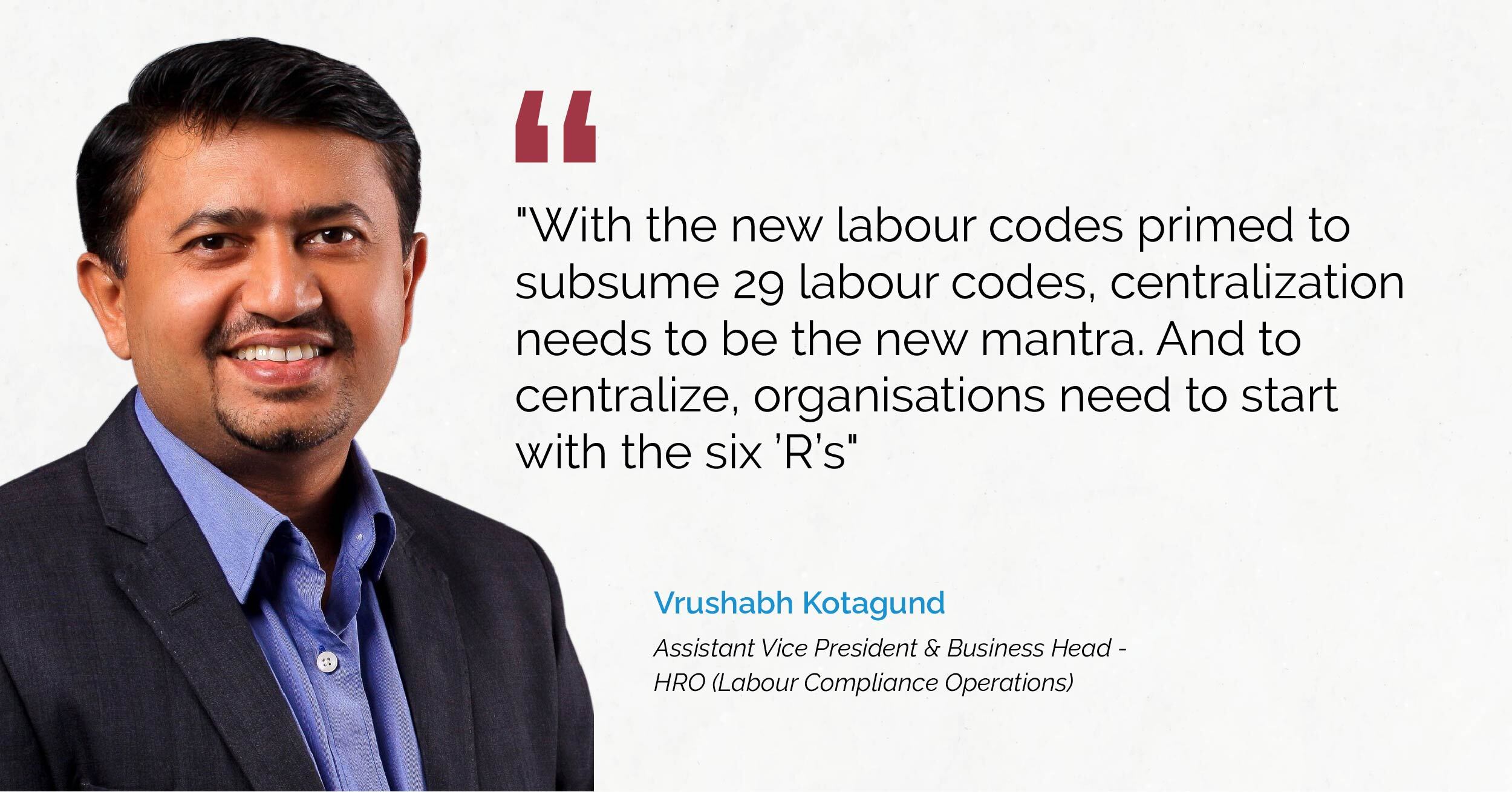
By Vrushabh Kotagund, Assistant Vice President & Business Head – HRO (Labour Compliance Operations)
Centralizing the Six “R”s That Rule HR Compliance
Change has always been a constant in the HR compliance world. On average, a CHRO in India has to oversee a plethora of regulatory updates in a month. And if the organization is multinational, staying compliant with the different country laws is like navigating a puzzling labyrinth.
Till now, HR managers across the country have used a decentralized approach to tackle compliance. However, with the new labour codes primed to subsume 29 labour codes, centralization needs to be the new mantra. And to centralize HR processes, organisations need to start with processes that handle the six basic “R”s—registrations, remittances, registers, returns, representations, and rules.
The Biggest Barrier to A Centralized System
The primary reason for organisations to fall short in their centralization efforts is having multiple compliance partners and monitoring teams. It results in a lack of communication and a higher error rate. There are also frequent delays in project completion, which causes the compliance score to plummet.
For example, consider an MNC that has offices in three different states. The prevalent practise is to have three separate teams on-site, to handle the recurring compliance processes. This model is not only expensive but it is also complicated to execute.
Outsourcing is one way for companies to avoid the drawbacks of having internal teams. In theory, it is cost-efficient, saves resources, and promises faster turnaround times. However, the mistake most companies make is to outsource their processes to multiple partners. This is counter-productive, for three reasons.
Firstly, different vendors operate on disparate timelines. This requires HR managers to scramble between compliance partners to complete every statutory requirement before the due dates. A delay with one vendor often derails the process and puts the company at risk of losing compliance scores.
The second issue lies in report creation. CHROs and CFOs need detailed reports on the state of compliance to sign off payments for remittances and registration fees. But when there are multiple partners involved, there is an inconsistency in the way data is represented. HR managers spend hours collating data points into one single document for the final sign-off. This amounts to hundreds of unproductive hours in a single quarter. Hours that can be diverted to activities that create lasting impacts in an organisation.
The final pitfall lies in accountability. When a compliance error occurs, there is often a lack of clarity on where it originated. This also means that the real compliance score is always unclear for an organisation that has multiple partners. Such a situation puts the entire organisation at risk, especially the CFO who signs the compliance verification document every cycle.
The Efficient Way To Centralize
Companies looking to centralize their processes need to look at the big picture. They cannot address the six “R”s independently. Each process should be in sync with every compliance department. And to achieve this coordination, it is necessary to focus on three important “R”s, that are not part of the main six—Real-time, Recurring, Reporting.
Each process update needs to be real-time for the stakeholders. Only then will they be able to make impactful business decisions. The next step should be to standardise reporting across all business locations. And for recurring processes, the data given to the teams needs to meet every deadline. When these processes are streamlined, the six “R”s fall into place automatically. Maintaining a good compliance score becomes a cakewalk.
For example, consider how Allsec boosted compliance scores for a global leader of the pharma industry with 30 factories and 13 vendors spread across India. When we started the project, their existing compliance score was 20%. The reason for this low score was the difference in process flows between their compliance partners. And since each worked independently of the other, there was minimal accountability.
After Allsec came into the picture their compliance scores are now at 97%. And with us as the only partner for pan-India operations, the client no longer faced accountability issues and achieved a massive reduction in operating costs. The transformation happened in three steps:
Step 1: Consolidation of Reporting & Data Processing
Every data point was analyzed at our Center of Excellence in Chennai. Zero data processing occurred at the local level. This led to standardised reporting across all locations.
Step 2: Reducing TAT for Recurring Processes
The entire recurring process was made low-touch. The fewer hands on deck reduced turnaround time for documentation and approvals.
Step 3: Increased Accountability through Real-time Updates
The client was provided with real-time updates through a central portal. It provided a birds-eye view of the entire process and assured our accountability.
A similar transformation occurred for a leading food procurement company. Their initial compliance scores were 40%. When Allsec centralized the process, it increased to 87% and continues to rise.
Compliance in The New Normal
Q3 of the 2021–2022 financial year is a crucial window for employers to evaluate compliance levels. According to Labour Ministry officials, the new labour codes will come into effect at the end of Q3. With ample time given for implementation, organisations that fall short on compliance scores are likely to face hefty fines
Parallel to the new changes in employment, a great resignation is happening. 95% of workers are considering a job change and 92% are willing to switch industries to find a position that suits them. This means employers need to revamp their compliance strategies to provide faster onboarding and swifter exit processes. If outsourcing, choose a single partner who can handle a centralised compliance flow end-to-end.
Always equate the compliance process with tending to a nursery. It has to be watered and nurtured every day. Organisations that centralize and partner with experts that can handle the management process end-to-end, will enjoy great dividends in the new normal.


